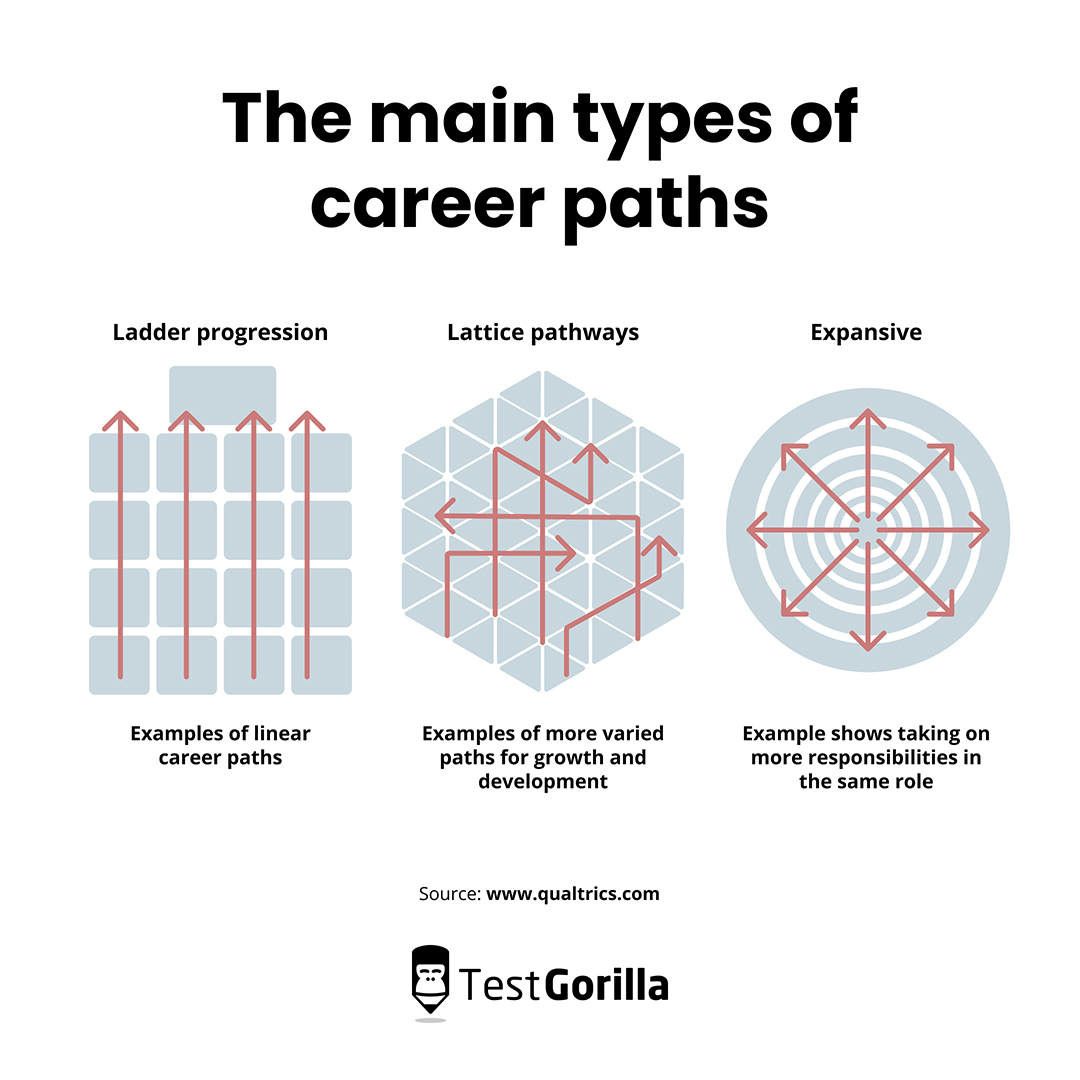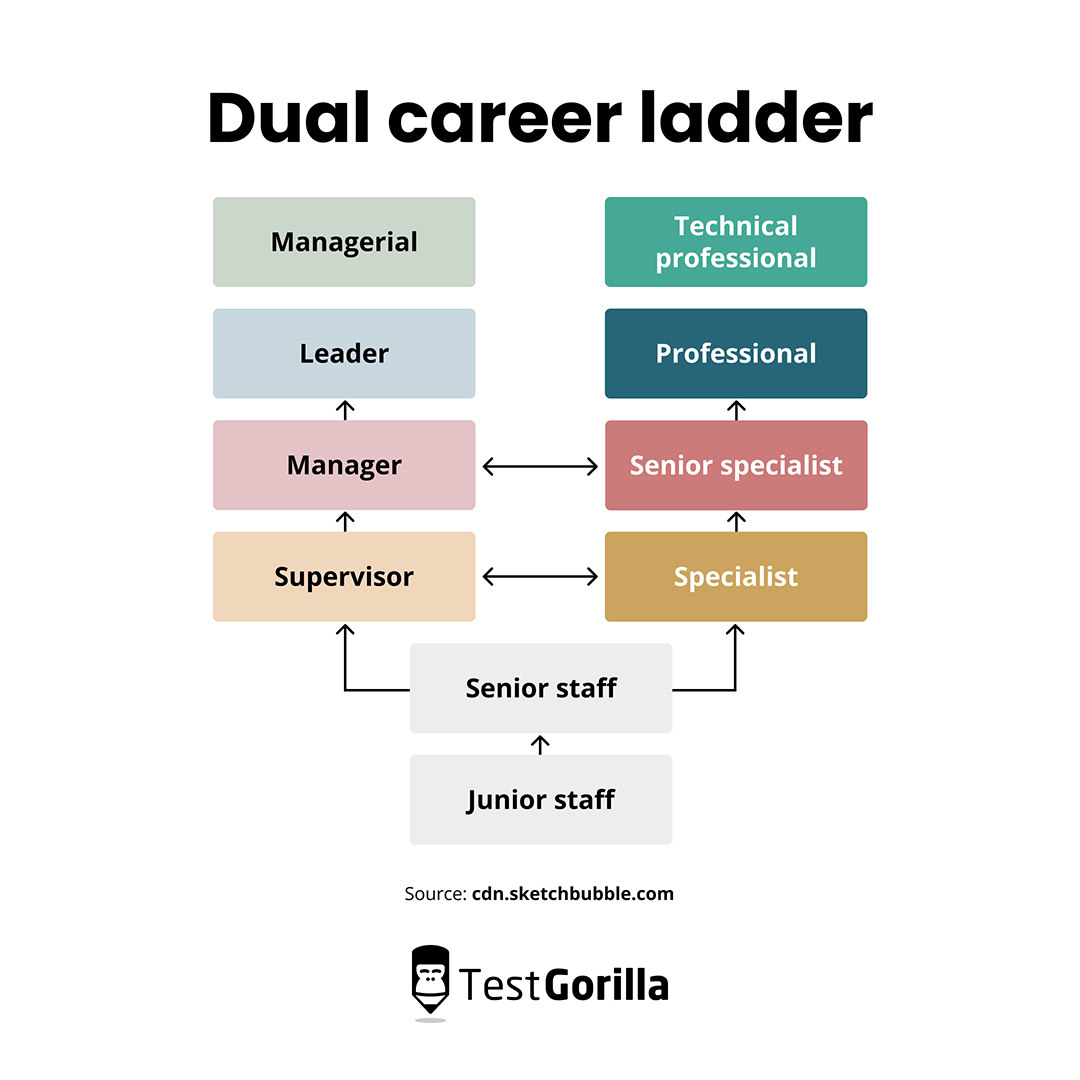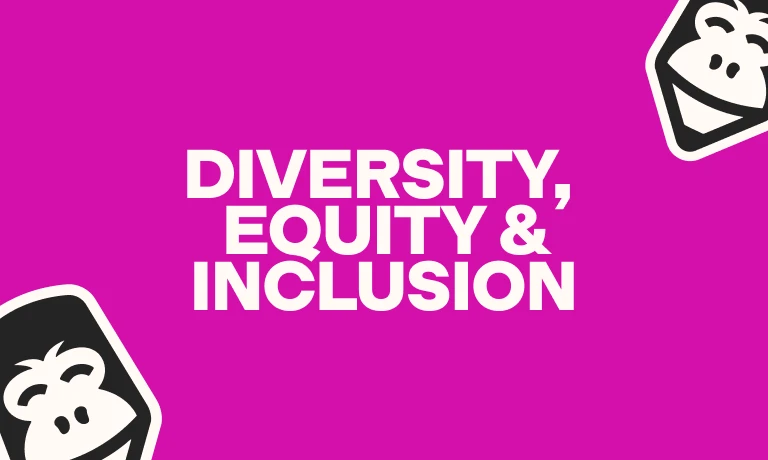How to implement career pathing at your organization
Professional growth is a top priority for your people.
Employees want to build skills, seize opportunities, and explore new roles – and if they can’t, they’re going to make an exit.
According to McKinsey, the biggest factor driving attrition between 2021 and 2022 was a lack of career development and advancement (41%).[1]
The solution is implementing career pathing programs at your organization.
Career paths encompass various potential advancement strategies, such as linear career ladders and atypical career lattices.
For example, some customer service representatives may want to move right into customer service management, but others might be looking to transfer their skills to a sales role.
Mapping out and providing these opportunities for your people helps you retain workers, fill skills gaps, and increase job satisfaction.
This in-depth guide to career pathing discusses why it’s crucial to a healthy organization, the eight steps to building successful career paths, and the best practices for a successful career pathing program.
Table of contents
- What is a career path?
- What is career pathing?
- Why is career pathing so important?
- The 8 steps for successful career pathing at any organization
- The 6 career pathing best practices for HR professionals
- Career pathing examples
- The dilemma: Career ladders or career lattices?
- Attract and retain top talent with career pathing
What is a career path?
A career path is a plan that describes the steps an employee must take to build the professional skills they need to reach a long-term goal.
The most well-known form of career path is a career ladder. They’re so well-known that many professionals believe they’re the only way to advance through a company.
The term career path is fairly new to the working world and encompasses many ways that an employee can grow professionally. A career path can be vertical, horizontal, or even expansive.
Here are the main career paths at a glance:
Career ladder (Vertical): A more traditional career path, called a career ladder, which involves moving directly upward – like a sales representative to a sales manager
Career lattice (Horizontal): Moving across teams and departments with the goal of building the right skills without direct upward mobility – like a customer service representative to an inside sales representative
Expansive: The concept of taking on more responsibilities in the same role, to grow skills and compensation without drastic movement – like a content writer to a marketing specialist
The term career path also includes the “dual career ladder,” which is a way for employees to move upward without going into managerial duties, but rather staying as an individual contributor.
There are so many more ways for an employee to grow than relying solely on traditional corporate ladders.
Hiring managers can individualize career path planning for each team member as part of their mentoring, so that they develop in a way that’s best for them.
This leads us to an important question.
What is career pathing?
Career pathing is the process of building a roadmap for employee growth and development opportunities that aligns with your organization’s talent needs.
Building a career path includes laying out the succession of roles an employee needs to occupy to achieve their eventual career goals.
A similar term is career planning or career mapping. A “career map” is a visual representation of an employee’s career pathing framework and the steps needed to achieve their end goal.
Career pathing is the act of building the journey and doesn’t necessarily have to involve visual career mapping. But a career map can help you and your worker organize each step of the journey.
The best insights on HR and recruitment, delivered to your inbox.
Biweekly updates. No spam. Unsubscribe any time.
Why is career pathing so important?
Professional growth and career advancement are non-negotiable in the modern era.
Employees demand learning and development programs as a part of the standard work experience.
This means that a culture of growth attracts new talent and retains current talent; employee development means better employee engagement.
These are the main benefits of career pathing:
Increases retention
Increases satisfaction
Boosts performance
Improves loyalty
Attracts top talent
All employees expect some type of career growth and advancement opportunities for true satisfaction – and employees matter more than ever in the current landscape.
Due to the Great Reshuffle and a global skills shortage, employees are now your most important asset, and retaining them is a top priority.
This means that the benefits an employee gains from their growth are also a win for the company because of increased skill levels and higher competency.
For example, career pathing gives workers major benefits like career growth and new skills. These benefits extend to the company when that employee can put their new skills to work.
The organization also benefits from increased retention due to a successful, satisfied employee. According to Glassdoor, 73% of employees change employers to advance in their careers – and this study was before the Great Reshuffle.[2]
But employers who offer growth opportunities see the opposite. One study showed that 70% of employees who are promoted within three years stay with their employer, versus only 45% who didn’t get promoted.
Another employee benefit that boosts your overall retention is better compensation. Career growth usually means increased pay, and “inadequate compensation” is the second largest cause of attrition.[1]
We encourage all organizations to adopt a learning mindset and continuously promote employee growth. Learning and development is one of our top recommendations in our guide to reducing turnover.
The 8 steps for successful career pathing at any organization
Each career path and company is different, but there’s still a base method for career path planning at every organization.
This guide tells you the general steps to implement career pathing, including identifying your goals, determining job role skills, and deciding on which career path suits each position.
A step-by-step guide to career pathing: A summary
Steps | Description |
1. Take stock of all current policies and processes relating to career progression | Assess your company’s current career growth processes and determine what’s working and what isn’t |
2. Identify your goals in implementing career pathing | Nail down what you hope to accomplish with career pathing, whether it’s employee retention or attracting new talent |
3. Establish the core roles, competencies, and structures in the area you’re developing | Talk to your team to determine each role’s responsibilities, necessary skills, and scope of work |
4. Decide on a career approach that best suits your business | Choose a career path that suits your organization or team, whether it’s a traditional career ladder or an atypical career lattice |
5. Start mapping career path routes | Build your career paths logically, ensuring every role has an opportunity for advancement |
6. Document, distribute, and communicate the plans to employees | Hand out your career path documents to managers so they can share them with their teams |
7. Use the new career pathing framework to update other relevant processes | Use the valuable data you gathered creating career paths to inform other processes, like recruiting and skills gap analyses |
8. Continue to update and improve your organization’s career pathing | Update your career paths regularly and recognize that this is an ongoing exercise |
1. Take stock of all current policies and processes relating to career progression
This is a crucial first step. You need to know your current position so you can build from there.
This means you need to consider:
How career progression currently works
How hiring is currently done
Where employees access policies and procedures
If current policy documents are up to date
These points require research and reflection on your part, but it’s also important to get information from others.
Ask the relevant staff, such as managers, about these processes and get some opinions. What’s working and what isn’t?
Use this information to get started on the career pathing process armed with the knowledge of current gaps and potential opportunities. This helps you create goals for your career path framework.
2. Identify your goals in implementing career pathing
Every important process, practice, and project requires you to identify why you’re doing it, which is why this step is also early in the process.
Why are you engaging in this project? What do you hope to gain? How will this influence your decisions and paths?
Here are a few common goals for implementing employee career pathing:
Boosting employee retention
Filling skills gaps
Increasing internal mobility
Building your learning and development strategies
Attracting new talent
Knowing what your aim is helps you shape your career pathing program, set benchmarks for success, and monitor the process.
3. Establish the core roles, competencies, and structures in the area you’re developing
Time to flesh out your career paths and the roles they contain.
We recommend gathering information on all your current positions, then establishing paths using this knowledge later on.
Talk to team members about their roles, asking how they got there, the skills they need to perform well, and where they’d like to progress to.
Then take that information and fill out the roles in detail.
Add responsibilities, who they work with and report to, the scope of work, and the salary range. Check in with managers and team members to ensure the details are correct, and ask for anything they’d like to add.
To go that extra mile and get objective data to drive your strategy, use career pathing tools like skills tests to identify which skills are used for each role.
This not only helps you determine the skills required for each job, but it also helps you establish which are the highest priority.
When you think you’ve gathered all the necessary skills and competencies, ensure you take a moment to share the document with your team before officially refining and finalizing it. It’s always a good idea to gather as much feedback as possible.
Now that you’ve recorded your roles, it’s time to link them in a progression that suits your organization.
4. Decide on a career approach that best suits your business
You now have a solid collection of your company’s roles and their details, including their responsibilities and the necessary skills. This means you have the required knowledge to link them together.
Choose a career path approach that suits your organization, or break it down by department – some teams may benefit from one approach over another.
The two main types of career paths are traditional, vertical career ladders, and modern, horizontal career lattices.
Here’s a clear definition of both:
Career ladder: The “tried and true” career path, a linear journey from junior staff to managerial work
Career lattice: An atypical career path that progresses through different roles, going horizontal through a company (and sometimes vertical, too)
Career ladders are a more traditional structure and are the type that most businesses are familiar with.
Career lattices may be a better option for employees who would rather diversify or prefer to stay out of managerial duties. These nontraditional paths also help workers build career portfolios.
Different organizations need different career paths, and no single career pathing framework suits everyone, as we discuss later in this article.
5. Start mapping career path routes
You now have all the puzzle pieces – let’s put them together.
This step is about taking the roles (with their detailed skills, responsibilities, and salaries) and connecting them with other roles, creating career path roadmaps.
Depending on your organization's preferences, these paths can be vertical, horizontal, or both.
Note: If you’re going to implement visual career maps, this would be the perfect time to do it.
Collaborate with managers and individual employees to ensure that the progression plans make sense. Use real context to make them practical, reasonable, and relevant.
For example, try referring to existing career path stories from employees or managers. It’s valuable to hear about successful career progression, but it’s also valuable to hear about career progression that didn’t work out well.
As you document your organization’s career paths, ensure that these opportunities for development and career progression are equal to everyone in the early stages. This helps you avoid bias and discrimination and ensures inclusivity.
Your company’s new career paths are now ready to go, so it’s time to document them and tell your workforce.
6. Document, distribute, and communicate the plans to employees
The early stages are always important, but this step makes the difference between a good career path program and a great one.
After you’ve carefully documented your career paths, run them by the relevant people (like managers) to ensure their clarity.
Now that the documents have been double-checked, hand them out to your managers, asking them to distribute the plans within their teams.
Career path planning is only successful when all your employees know about it (more details on this below) – not just your human resources department.
Invite feedback, questions, and dialogue from all your employees – managers should also be available for regular 1:1 meetings to review the pathways and how they relate to the employee.
Your employees are now well on their way to advancing professionally and gaining new skills. So are we done with the career pathing process? Not quite.
7. Use the new career pathing framework to update other relevant processes
Career paths are beneficial on their own, but they also help you update other processes.
Your career path documentation is most valuable and actionable when it feeds logically into other processes, like professional development plans (PDPs).
Your career pathing framework helps you inform:
Professional development plans: Planning out an employee’s goals and the strategies to achieve them is much easier when you have a framework of the roles they must enter and pass through.
Hiring initiatives: Knowing your company’s career paths helps you hire for the future. For example, you hire a data entry specialist with great communication skills because your career paths show that you typically have data entry workers move into customer success.
Skills gap analyses: Using detailed career path documents helps inform you of the necessary skills when conducting a skills gap analysis.
Using career pathing documents to inform other processes not only keeps your company processes consistent but also maximizes the value you get from your work.
There’s no need to gather all the skills and competencies for each role again – the hard work has already been done.
8. Continue to update and improve your organization’s career pathing
Almost done, but this step is important.
Career path planning shouldn’t be a one-and-done process. You should revisit this program regularly to ensure it’s kept up-to-date.
Career pathing should always change and develop over time, so schedule regular dates to perform this exercise again in the future.
“Continuous improvement” is a term thrown around a lot, but it isn’t just for employee growth; it’s also for organizational growth.
An organization’s needs change, and roles evolve, too. It’s best to keep growing these practices and never let them get stale.
The 6 career pathing best practices for HR professionals
Now you know the basic steps to creating a career pathing framework, but these are the tips and strategies to make your program shine.
Career pathing best practices: A summary
Strategies | Descriptions |
Use current talent to build future talent through training programs | Encourage knowledge sharing and succession planning by using existing talent |
Always link your career pathing efforts to your overall organization and skills needs | Plan for the skills and roles your company needs by assessing current skills gaps |
Use feedback loops to encourage continuous improvement | Encourage regular feedback from every relevant source to assist development |
Create a career development culture | Weave learning and development into your company culture to make it second nature |
Make your learning opportunities known | Clearly announce learning opportunities to current employees Make your stance on development clear to potential candidates |
Use skills tests to evaluate which employees are ready to progress | Evaluate employees with skills tests to accurately gauge where they are in their development |
1. Use current talent to build future talent through training programs
Make use of existing talent to help foster future talent through formal and informal mentorship and training programs.
Once you know your company’s established career paths, it becomes straightforward to have current talent help new hires build the right skills to succeed in their career paths.
This is a great practice in general, but it has two specific uses:
Helping grow the careers of senior employees looking for more opportunities (particularly, being able to grow your career without leaving your position)
Sharing knowledge between generations and aiding in succession planning
For our full guide on the subject, read our blog on succession planning.
2. Always link your career pathing efforts to your overall organization and skills needs
Employee growth is always important, but it must also serve your company’s goals and needs.
For example, mapping out career paths for 10 future marketing strategists is only a good idea if your company is going to need that many new marketing strategists.
On the other hand, a company with a solid idea of the future skills they need can specifically map out career paths as a focused talent strategy.
This is crucial when the skills required for a single job are increasing by 10% every year.
How do you discover which future positions your organization will need?
Use skills tests to help you identify internal skills gaps. This process helps you understand the skills your teams are missing, which informs your career pathing strategy.
Using objective data to plan for future skill needs is imperative when jobs are changing faster than ever. For more information on this, read our article on how to stay ahead of the curve when necessary skills keep changing.
3. Use feedback loops to encourage continuous improvement
Encourage regular feedback to help individuals grow and keep them focused on developing their skills. This helps them move along their path smoothly.
All feedback is welcome, but for the most detailed results, try 360 feedback loops. This type of feedback involves gathering data about a worker from all possible sources, including:
Managers
Customers
Colleagues and peers
Employees
Self-assessments
Employees crave feedback to help them improve their performance. Research has shown that an employee who receives regular, meaningful feedback is four times as likely to be engaged.
Feedback is crucial for two main reasons:
It keeps employees focused and ensure they don’t continue with incorrect knowledge or practices
It ensures you provide as much help as possible to help their growth
Remember to give both positive and negative feedback in your performance review. You want your workers to know what isn’t working, but you also want to encourage what they’re doing well.
4. Create a career development culture
Nurture a culture where career development is normal and encouraged.
Career development alone is important, but building it into your culture helps weave it into your natural processes and instills a development mindset in every worker, meaning that::
Managers have a mindset of helping employees define their goals and aspirations and don’t just leave it up to them
Employees own their development, take responsibility, and stay accountable for their actions
In a development-minded culture, every level of the company recognizes the part growth plays in an organization. For example, middle managers coaching employees, or HR leaders and other executives pushing new learning initiatives and policies.
This mindset promotes healthy, steady development from all levels.
5. Make your learning opportunities known
Nothing is assumed – ensure employees and potential candidates alike know about your career pathing and opportunities.
Announce career paths and job openings openly and give inclusive access to them. This means that every worker should be able to access growth opportunities.
It’s simple to keep employees informed when you use career pathing tools like an internal talent marketplace. This system enables you to clearly post new opportunities for all employees to see.
This is great for announcing opportunities internally, but it’s just as important to talk about development externally.
Shout your values from the rooftops. Let potential candidates know that you’re an organization that prioritizes learning and career paths. It’s great for your brand image and helps attract top talent.
In fact, nearly half (48%) of American workers say they would switch jobs if it offered opportunities to build new skills.
We’d recommend mentioning your commitment to development on your website, social media, and even during interviews.
6. Use skills tests to evaluate which employees are ready to progress
One of the most important career pathing tools is skills testing software.
Skills tests objectively and accurately assess skills and capabilities so you can inform your own career pathing program with real data.
Evaluating employees with pre-employment assessments shows you if they’re ready for a few new responsibilities, or if they’re ready for the full next step into a new role.
Skills assessments are part of a greater skills-first mindset. Skills-based practices prioritize necessary skills above connections, education, and history. This helps companies to find hidden talent and fill positions more smoothly.
It also enables employees to advance through career paths that they have the skills for, instead of relying solely on certifications.
This is one of the main reasons that skills-first organizations maintain great agility, even during uncertain times. For more information, read our article on how skills-based organizations become more adaptable.
Career pathing examples
Let’s take a look at a few different types of career pathing examples, using both ladders and lattices.
Example 1: Transportation and delivery company
Here’s an example of a career ladder from FedEx:[3]
Package handler: An entry-level position that requires delivery, driving, and people skills
Office administrator: Coordinates office tasks, such as handling payroll and organizing filing systems
Operations manager: Manages administrative employees, including hiring, firing, and coaching
Ops coordinator: Provides operational and administrative support to managers and senior managers
Operations administrator: Coordinates process-related tasks, such as tending to damaged packages and handling customer issues
Maintenance technician: Handles preventive mechanical maintenance work
Maintenance service manager: Manages and supervises a group of maintenance technicians.
Although it is a somewhat traditional ladder, it still offers flexibility by enabling employees to go down multiple routes. One path is more admin- and office-focused, while the other is more technical.
This is an inclusive career path because both paths start as a package handler, an entry-level position.
Example 2: Healthcare
This example is a straightforward, linear ladder from an “out of college” entry-level nurse to an RN:
Pre-nursing assistant
Nursing assistant (CNA)
Pre-nursing
Practical nurse (LPN)
Associate degree nurse (RN)
Although it’s worth noting that not every nurse has to start fresh out of college. Many healthcare professionals can advance through job training programs to help fill the coming nursing gap.
For more information, read our blog on skills-based hiring in the healthcare sector.
Example 3: Finances
For our last example, let’s take a look at a career lattice in the finance industry:
Beginning roles | Advanced roles |
Brokerage clerk | Stockbroker |
Financial executive | Financial Analyst |
Analyst | Financial Advisor |
This breaks down the potential roles to a more simplistic “beginning” and “advanced.” With this structure, there are many different combinations of possible career growth.
Using these roles, here’s a potential career path an employee could follow:
Analyst
Financial analyst
Financial advisor
You can see that the employee moves from one advanced role to another. It’s not necessarily upward – it’s horizontal, but it still enables the employee to grow and gain new skills.
The dilemma: Career ladders or career lattices?
So which career path is best for your organization?
There’s no right or wrong answer.
When choosing, it’s smart to analyze what both paths entail and how they would work at your company.
You can make the most informed decision when you break down what each path would require:
Career ladder: Moving from one role to a similar one; requires upskilling
Career lattice: Moving from one role to another role that’s not necessarily similar; may require reskilling
Upskilling and reskilling are both excellent strategies for your workplace.
Upskilling is the process of supplementing an employee with additional training to further their current skills, while reskilling is the process of training an employee on new skills.
Upskilling employees along a career ladder helps them specialize in a particular field and become subject matter experts. However, reskilling employees along a career lattice helps them develop varied skill sets and a career portfolio, rendering them more agile in the face of future changes and technological advancements.
Another factor in determining which career path to adopt is whether or not the employee wants to pursue managerial duties or prefers to stay as an individual contributor.
Attract and retain top talent with career pathing
Effective career pathing is a people strategy that pays dividends.
Employees demand professional growth, and when you supply it, you increase retention, satisfaction, and company loyalty.
Career pathing is non-negotiable in the modern age. The only question is how you do it.
Career ladders and career lattices are both solid options for development depending on the company, individual, and role in question.
Keep this post in your back pocket when planning your career pathing framework, and refer back to it whenever you need some advice on which plan to choose.
For more information on how to reduce employee churn and boost satisfaction, read our blog on employee retention strategies.
To use skills tests to gauge if an employee is ready to move in their career path, check out our test library.
Sources
De Smet, Aaron, et al. (July 13, 2022). "The Great Attrition is making hiring harder. Are you searching the right talent pools?". McKinsey & Company. Retrieved June 27, 2023. https://www.mckinsey.com/capabilities/people-and-organizational-performance/our-insights/the-great-attrition-is-making-hiring-harder-are-you-searching-the-right-talent-pools
Smart, Morgan. (February 2017). "Why Do Workers Quit? The Factors that Predict Employee Turnover". Glassdoor. Retrieved June 27, 2023. https://www.glassdoor.com/research/app/uploads/sites/2/2017/02/GD_ResearchReport_WhyWorkersQuit_Rebrand_Draft3-1.pdf
"Developing Employee Career Paths and Ladders". SHRM. Retrieved June 27, 2023. https://www.shrm.org/resourcesandtools/tools-and-samples/toolkits/pages/developingemployeecareerpathsandladders.aspx
You've scrolled this far
Why not try TestGorilla for free, and see what happens when you put skills first.
















